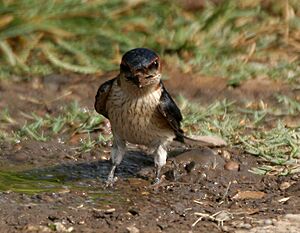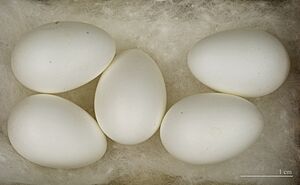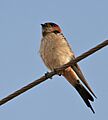Red-rumped swallow facts for kids
Quick facts for kids Red-rumped swallow |
|
|---|---|
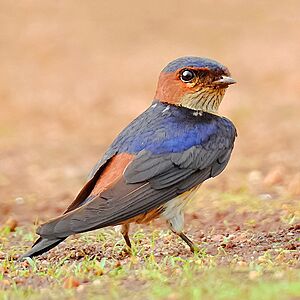 |
|
| Red-rumped swallow in Mangaon | |
| Conservation status | |
| Scientific classification | |
| Genus: |
Cecropis
|
| Species: |
daurica
|
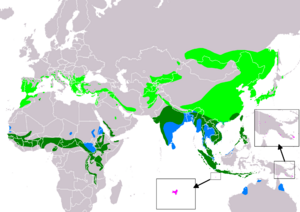 |
|
| Range of C. daurica Breeding Resident Non-breeding Vagrant (seasonality uncertain) | |
| Synonyms | |
|
|
The red-rumped swallow (Cecropis daurica) is a small bird from the swallow family. It lives in hilly areas of southern Europe and Asia. You can find them from Portugal to Japan, and even in India and parts of Africa.
Some red-rumped swallows stay in one place all year. These are the birds in India and Africa. But many European and Asian swallows are migratory. This means they fly to warmer places like Africa or India for winter. Sometimes, they even visit Christmas Island or northern Australia.
These swallows look a bit like other birds that catch insects in the air. They have blue feathers on their backs. Their bellies are a bit darker.
They are similar to barn swallows. But red-rumped swallows have a pale or reddish patch on their rump, face, and neck. They do not have a dark band across their chest. They are very fast flyers. They swoop through the air to catch insects. They have wide, pointed wings.
Contents
About the Red-Rumped Swallow
Red-rumped swallows build special nests. They use mud that they collect with their beaks. Their nests are shaped like a quarter-sphere with a tunnel entrance. Inside, they lay 3 to 6 eggs.
These birds usually build nests under cliffs in mountains. But they can also build them on buildings. Mosques and bridges are common places for their nests.
Red-rumped swallows do not usually live in big groups when they are nesting. But outside of nesting season, they like to be together. You can see hundreds of them in places like India.
Scientific Name and History
The red-rumped swallow was first described in 1769. A scientist named Erik Laxmann gave it the name Hirundo daurica. Later, in 1826, another scientist named Friedrich Boie put it in a new group called Cecropis.
The name Cecropis comes from an old Greek word. It refers to a woman from Athens. The name daurica comes from Dauria. This is a mountain area in Russia, near Lake Baikal. The word Hirundo is the Latin word for "swallow."
Where Red-Rumped Swallows Live
Red-rumped swallows breed in southern Europe and Asia. Their breeding areas go all the way to southern Siberia and Japan. Birds from these areas fly to sub-Saharan Africa or south Asia for winter.
Some groups of red-rumped swallows live in Africa all year. They are found from West Africa to Ethiopia and south to Tanzania. Most swallows in India and Sri Lanka also stay in their homes all year. Sometimes, African and Asian swallows move locally with the seasons.
How They Live and Eat
These swallows often fly over grasslands. They hunt for insects in the air. They might even fly near grass fires or grazing cattle. This is because these things can make insects fly up into the air.
Nesting and Reproduction
Red-rumped swallows are known for their unique mud nests. They start by building an open cup. Then, they close it up. Finally, they add a long tunnel for an entrance. This special nest design helps protect their eggs and young birds. It also makes it harder for other male swallows to get inside. This means the male and female swallows can raise their family in peace.
Conservation Status
The International Union for Conservation of Nature (IUCN) checks on how many animals are left. They decide if a species is in danger. A species is in danger if its numbers are very low or dropping fast.
The red-rumped swallow is doing very well. It lives in a huge area. There are millions of these birds. Their numbers are not dropping. Because of this, the IUCN says the red-rumped swallow is of Least Concern. This means it is not currently in danger.
In recent years, red-rumped swallows have been moving further north in Europe. They have started living in France and Romania. In Europe, there are about 100,000 to 430,000 pairs of breeding swallows. This means there are between 300,000 and 1,290,000 individual birds.
Images for kids
-
Collecting mud for nest construction (Parli, Maharashtra, India)
-
At Ananthagiri Hills, in Rangareddy district of Andhra Pradesh, India.
-
Collecting mud for nest construction (Parli, Maharashtra, India)
-
At Ananthagiri Hills, in Rangareddy district of Andhra Pradesh, India.
-
Red-rumped swallow on wire (Hong Kong)




